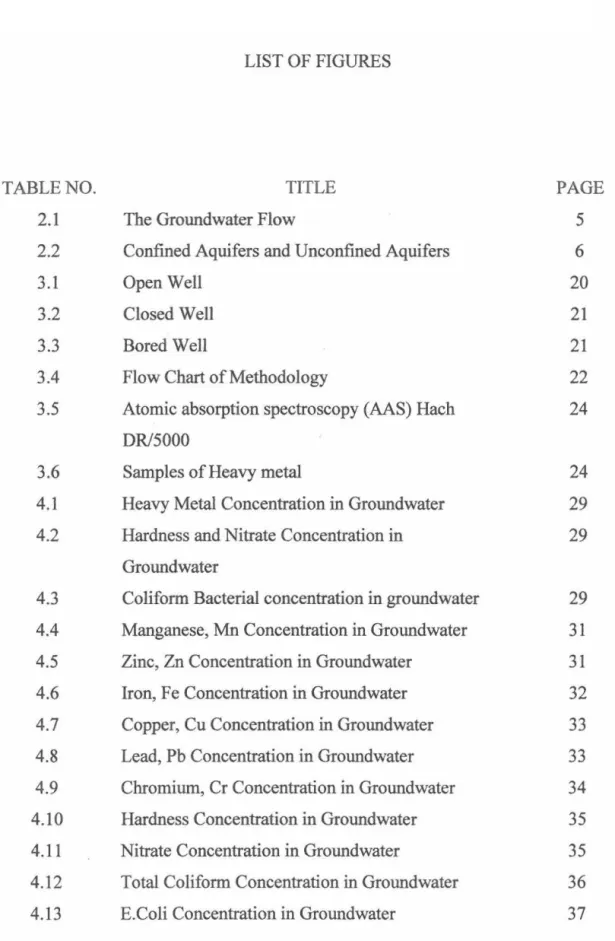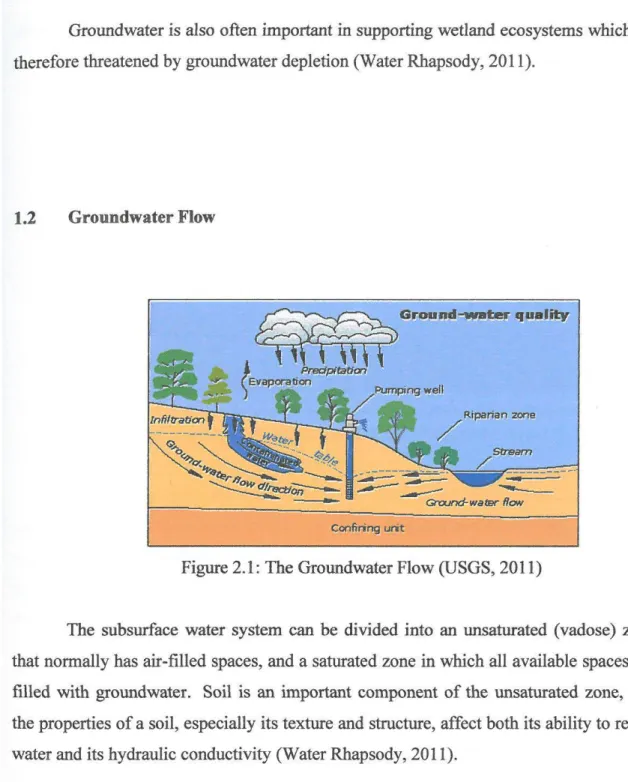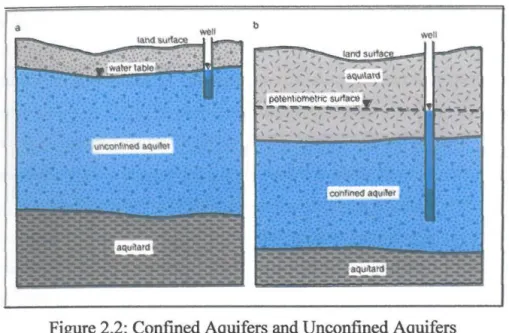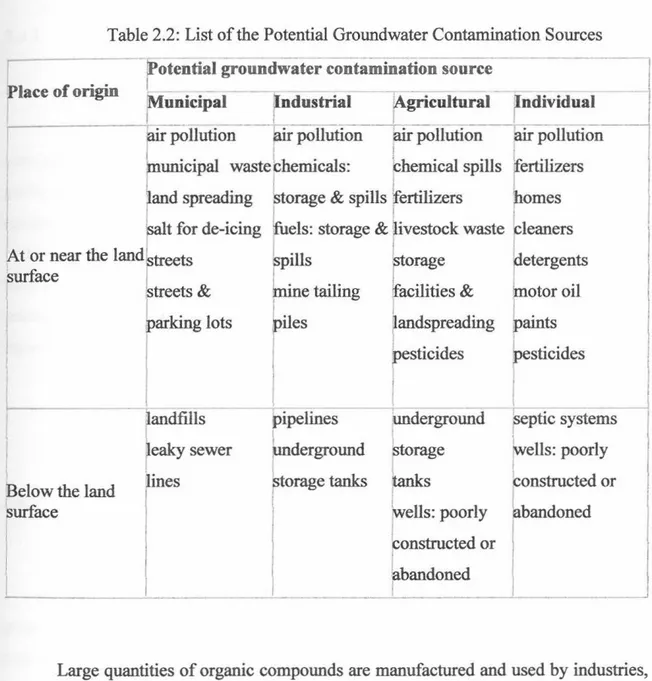SITI NOOR AIN BINTI MUHAMAD HUSAIN
Report submitted in partial fuJfillment of the requirements for the award of Bachelor of Civil Engineer
Faculty of Civil Engineering & Earth Resources UNIVERSITI MALAYSIA P AHANG
ABSTRACT
In Malaysia, groundwater is one of the sources of clean water, other than fresh river water and rain. Thus, this research had been done to determine the groundwater quality and also the effective type of well that can contribute to the good quality of groundwater. The parameters were considered such as manganese, iron, copper, zinc, chromium, lead, hardness, nitrate, total coliform and E.Coli in this study. The water samples were collected three times and from three different type of well such as open well, closed well, and bored well. The results were compared to the Interim National Drinking Water Quality Standard (INDWQS) to know the class of the groundwater for each well. The result showed that the groundwater had been contaminated by the chromium with concentration of 0.149 mg/L which found in open well. This result considered as relativelv not in verv hiizh concentration even the concentration of element is higher than the standard stated by lnterim National Drinking Water Quality Standard <lNDWOS). Meanwhile. for biolo1rical analvsis. result showed that total coliform and E.coli have highest contamination which was found in open well with total coliform concentration 247.95 MPN/100 mL and E.coli concentration is 167.17 MPN/100 mL. As the conclusion, the groundwater quality was harmless from heavy metal concentration but highly contaminated with total coliform and E.coli.
ABSTRAK
Di Malaysia, air tanah merupakan salah satu punca air bersih selain daripada air sungai segar dan hujan. Oleh itu, kajian ini telah dibuat untuk menentukan kualiti air tanah dan jenis telaga yang berkesan dalam membantu dalam melindungi kualiti air tanah. Antara parameter yang telah dikaji adalah mangan, ferum, kuprum, zink, chromium, besi, keliatan, nitrat, Total Coliform dan E.coli. Sampel air telah diambil sebanyak tiga kali dan di tiga jenis telaga yang berbeza seperti telaga terbuka, telaga tertutup dan telaga tiub. Keputusan dibandingkan dengan Interim Piawaian Kualiti Air Minuman Negara bagi mengetahui kelas air tanah bagi setiap telaga. Keputusan menunjukkan air tanah telah dicemari oleh kepekatan chromium iaitu sebanyak 0.149 mg/L yang mana ditemui di dalam telaga terbuka. Keputusan ini dianggap sebagai tidak terlalu tinggi kepekatannya walaupun kepekatan chromium meiebihi piawaian yang diberikan. Manak:ala bagi keputusan untuk analisis biologi, Total Coliform dan E.coli mempunyai kepekatan yang tinggi yang mana ditemui di dalam telaga terbuka. Keputusan bagi kepekatan Total Coliform adalah 247.95 MPN/100 mL dan bagi E.coli adalah 167.i 7 MPN/iOO mL. Sebagai kesimpulan, kualiti air tanah tidak tercemar oleh kepekatan logam berat tetapi telah tercemar oleh kepekatan Total Coliform dan E.coli.
TABLE OF CONTENTS
CHAPTER TITLE PAGE
DECLARATION Supervisor's Declaration Student's Declaration 11 DEDICATION ill ACKNOWLEDGEMENTS IV ABSTRACT v ABSTRAK VI TABLE OF CONTENTS vu LIST OF TABLES x LIST OF FIGURES XI LIST OF ABBREVIATIONS XU LIST OF SYMBOLS Xlll 1 INTRODUCTION 1.1 Introduction 1 1.2 Problem statement 2
1.3 Objectives of the study 3
1.4 Scope of study 3
2 LITERATURE REVIEW
2.1 Introduction 4
2.3 Groundwater quality 7 2.3.l Groundwater classifications 7 2.3.2 Groundwater quality standard 8
2.3.3 Groundwater quality criteria 9
2.4 Sources of groundwater pollution 10
2.4.1 Natural 12 2.4.2 Agricultural 12 2.4.3 Industrial 13 2.4.4 Residential 14 2.5 Groundwater parameter 15 2.5.1 Iron 15 2.5.2 Manganese 16 2.5.3 Zinc 17 2.5.4 Coliform bacteria 18 3 METHODOLGY 3.1 Sampling site 19
3 .2 Water sampling and preservation 20 3.3 Water quality analysis 22 3 .4 Atomic absorption spectroscopy 24
4 ANALYSIS & DISCUSSION
4.1 Introduction 26
4.2 Result analysis 26
4.3 Analysis for each parameter
4.3.1 Manganese 30
4.3.2 Zinc 31
4.3.4 Copper 32 4.3.5 Lead 33 4.3.6 Chromium 34 4.3.7 Hardness 34 4.3.8 Nitrate 35 4.3.9 Total coliform 36 4.3.10 E.Coli 36 4 .4 Discussion
4.4.1 National Guideline for Raw Drinking Water 37 Quality
4.4.2 Interim National Drinking Water Quality 38 Standard for Malaysia
5 CONCLUSION & RECOMMENDATION
5.1 Conclusion
40-5 .2 Recommendations 41
REFERENCES 44
LIST OF TABLES
TABLE NO. TITLE PAGE
2.1
Water use classes in the national water quality 10 standard2
.
2
List of the Potential Groundwater Contamination 11 Sources3.1
List of Parameter, Method and Model23
4.1
Result for First Sample27
4
.
2
Result for Second Sample27
4.3
Result for Third Sample28
LIST OF FIGURES
TABLE NO. TITLE PAGE
2.1
The Groundwater Flow5
2.2
Confined Aquifers and Unconfined Aquifers6
3.1
Open Well20
3.2
Closed Well21
3.3
Bored Well21
3.4
Flow Chart of Methodology22
3.5
Atomic absorption spectroscopy (AAS) Hach24
DR/5000
3.6
Samples of Heavy metal24
4.1
Heavy Metal Concentration in Groundwater29
4.2
Hardness and Nitrate Concentration in29
Groundwater
4.3
Coliform Bacterial concentration in groundwater29
4.4
Manganese, Mn Concentration in Groundwater31
4.5
Zinc, Zn Concentration in Groundwater31
4.6
Iron, Fe Concentration in Groundwater32
4.7
Copper, Cu Concentration in Groundwater33
4.8
Lead, Pb Concentration in Groundwater33
4.9
Chromium, Cr Concentration in Groundwater34
4.10
Hardness Concentration in Groundwater35
4.11
Nitrate Concentration in Groundwater35
4.12
Total Coliform Concentration in Groundwater36
LIST OF SYMBOLS Mn
=
Manganese Fe=
Ferum/Iron Zn Zinc Cr Chromium Cd=
Cadmium Pb=
Plumbum/Lead N03=
Nitrate mg=
milligrammg/L
=
milligram per litreMPN/IOOmL
=
Most Probable Number per hundred milliliter% = Percent
N = North
E
=
EastLIST OF ABBREVIATIONS
INDWQS = Interim National Drinking Water Quality Standard NSW government = Government of New South Wales
Mld = Million liter per day
NQWS = National Quality Water Standard USGS = United States Geological Survey GWQS
=
Ground water quality standardMDEQ = Michigan Department of Environment Quality Kg.
=
KampungGPS Global Positioning System WHO = World Health Organization AAS = Atomic Absorption Spectroscopy
CHAPTERl
INTRODUCTION
1.1 Introduction
Water is essential to human life and the health of the environment. As a valuable natural resource, it comprises marine, estuarine, freshwater (river and lakes) and groundwater environments that stretch across coastal and inland areas. Water has two dimensions that are closely linked: quantity and quality. Water quality is commonly defined by its physical, chemical, biological and aesthetic (appearance and smell) characteristics. A healthy environment is one in which the water quality supports a rich and varied community of organisms and protects public health (NSW government).
Water quality is also related to the surrounding environment and land use. The water can be affected by human activities such as agriculture, urban and industrial use, and recreation. In addition, the modification of natural stream flows by dams and weirs also affect water quality. Therefore, water quality is very important to protect people's health and to ensure the ecosystem habitats. If water quality is not maintained, it is not only
1.2 Problem Statement
The demand for water in Malaysia is expected to grow significantly by 20 l 0 to approximately 17,000 Mld when the country's population reaches 30 million. Currently, surface water accounts for more than 98 per cent of water consumed in Malaysia. This is a level of dependence is unsustainable and needs urgently to be addressed, especially since surface water is easily affected by extreme weather conditions, as Malaysians know only too well. This is a matter of grave concern for the whole country and all responsible organizations should be looking into addressing this imbalance in our national water supply. Groundwater offers a more reliable and sustainable source of water as long as it is abstracted correctly, utilizing appropriate methods and technology (Sime Darby, 2011).
Groundwater is globally important for human consumption, and changes in quality with subsequent contaminant can affect human life. The chemical composition of groundwater is a measure of its suitability as a source of water for human consumption and for the other purposes, and also influences ecosystem health and function (Appelo & Postma, 1993).
Therefore, the research project is being done to measure the suitability of the ground water that being study as a source of water for human consumption and for the other purposes.
The objectives of this research are as follows:
1. To determine the quality of well water (groundwater) at Kampung Jaya Gatling,
Kuantan, Pahang
2. To compare the quality of groundwater based on type of well at Kampung Jaya
Gatling, Kuantan, Pahang.
1.4 Scope of Study
Research area is located at the rural area where peoples are mostly used groundwater as their main source of water. The samples were taken from different type of well such as open well, closed well and bored well. The selected parameters were used as indicators of groundwater quality are manganese (Mn), iron (Fe), zinc (Zn), hardness, nitrate, E.coli and total coliform bacteria. The value of each parameter is
evaluated against the National Quality Water Standard (NQWS) to identify the current status of the groundwater whether polluted or not.
CHAPTER2
LITERATURE REVIEW
2.1 Introduction
Ground water is among the Nation's most important natural resources. It is the source of about 40 percent of the water used for public supply and provides drinking water for more than 97 percent of the rural population who do not have access to public water-supply systems. Between 30 and 40 percent of the water used for the multi-billion-dollar agricultural industry comes from ground water. Withdrawals of ground water are expected to rise in the coming century as the population increases and available sites for
surface reservoirs become more limited (USGS, 2011 ).
In many catchments, groundwater and surface water levels are intimately linked,
and groundwater is responsible for river base flows which continue when there is has been little rainfall for some time. In these systems, river low flows during droughts can be partly due to over-abstraction of groundwater (Water Rhapsody, 2011).
1.2 Groundwater Flow
Confiring urit
Figure 2.1: The Groundwater Flow (USGS, 2011)
The subsurface water system can be divided into an unsaturated (vadose) zone that normally has air-filled spaces, and a saturated zone in which all available spaces are filled with groundwater. Soil is an important component of the unsaturated zone, and the properties of a soil, especially its texture and structure, affect both its ability to retain water and its hydraulic conductivity (Water Rhapsody, 2011).
If percolating water encounters an impermeable layer in the unsaturated zone, it may accumulate or move down inclines as interflow, but this is usually a minor and intermittent flux compared with percolation to the saturated zone. Within the saturated zone, groundwater is usually held in strata of porous rock called aquifers, of which there are two main types - confined aquifers and unconfined aquifers. Two other types occur in some areas: (a) a 'leaky' aquifer is partially confined below a semi-impervious layer,
Figure 2.2: Confined Aquifers and Unconfined Aquifers
Globally, groundwater constitutes 97% of all liquid fresh water. The storage capacity of an aquifer depends largely on dimensions and porosity - and many strata (e.g. clays and shales) are not usually classed as aquifers because the porous material is thin ( <50m) and the groundwater supply tends to be small and unreliable during droughts (Water Rhapsody, 2011).
Groundwater flows down inclines but flow rates are generally slow, rarely exceeding lOm/day and sometimes less than Im/year. Moreover, the deeper in the aquifer the water is, the more slowly it moves. Water can move a short distance upwards from a water table by capillary rise and can be drawn further upwards by 'evaporative pull' (exerted by evapotranspiration). However, groundwater cannot reach the surface from the deep water tables; and in these situations (a) it is not available to vegetation, and (b) abstraction requires pumping. In some places, it reaches ground level and emerges as a spring, or seeps directly into a watercourse or water body (Water Rhapsody, 2011).
For the Nation as a whole, the chemical and biological character of ground water is acceptable for most uses. The quality of ground water in some parts of the country, particularly shallow ground water, is changing as a result of human activities. Ground water is less susceptible to bacterial pollution than surface water because the soil and rocks through which ground water flows screen out most of the bacteria. Bacteria,
however, occasionally find their way into ground water, sometimes in dangerously high concentrations. But freedom from bacterial pollution alone does not mean that the water is fit to drink. Many unseen dissolved mineral and organic constituents are present in ground water in various concentrations. Most are harmless or even beneficial: thoui:zh
occurring infrequently, others are harmful, and a few may be highly toxic (USGS, 2011).
2.3.1 Ground Water Classifications
The GWQS establish three major classes of ground water: Class I Ground Water of Special Ecological Significance, Class II Ground Water for Potable Water Supply, and Class III Ground Water with Uses Other Than Potable Water Supply.
1. Class I Ground Water of Special Ecological Significance: Class 1 includes ground water within watersheds of FWl surface waters, State-owned Natural Areas, and the major aquifers of the Pinelands Area. The designated use for Class I ground water is the maintenance of special ecological resources. Secondary uses include potable, agricultural and industrial water. 2. Class II Ground Water: Class II ground waters include all areas that are not
other than for potable water. For Class III ground water, where existing ground water quality is better than the ground water quality criteria, the GWQS allow degradation of ground water quality up to the applicable criteria.
2.3.2 Ground Water Quality Standards
The Ground Water Quality Standard (GWQS), establish the designated uses of the State's ground waters, classify ground waters based on those uses, and specify the water quality criteria and other policies and provisions necessary to attain those designated uses. The ground water quality criteria are numerical values assigned to each constituent (pollutant) discharged to ground waters of the State. The GWQS also contain technical and general policies to ensure that the designated uses can be adequately protected. Ground water is classified according to its hydrogeologic characteristics and designated uses (Department of Environmental Protection, 2011).
Designated uses are assigned as primary or secondary uses of ground water and include maintenance of special ecological resources, provision of and conversion to portable water, agricultural and industrial water supply, and other reasonable uses (other than potable use). For all ground waters of the State, the GWQS assign designated uses of the ground water within each classification, and establish numerical water quality criteria to support those uses. The GWQS also establish antidegradation policies, which are designed to protect the existing and designated uses of the State's ground waters (Department of Environmental Protection, 2011).
The GWQS establish ground water quality criteria for the different ground water classifications:
1. Class I Ground Water: Ground water quality criteria for Class 1 ground water is natural quality for each constituent in Class I-A and Class I-PL (Pinelands Preservation Area) ground water, and background water quality for Class I-PL (Pinelands Protection Area) ground water. Class 1 ground waters are nondegradation waters.
2. Class II Ground Water: Class II ground water quality criteria specify the levels of constituents above which would pose an unacceptable risk for using ground water for drinking water purposes. The applicable ground water quality standard for a particular constituent is the higher of the PQL and the ground water quality criterion.
3. Class ID Ground Water: The ground water quality criteria for Class III-A ground water are the Class II-A criteria. The ground water quality criteria for
CLASS I Conservation of natural environment water supply I -practically no treatment necessary.
Fishery 1 -very sensitive aquatic species
CLASS Water Supply II - conventional treatment required
llA Fishery 11 -sensitive aquatic species
CLASS Recreational use with body contact
IIB
CLASS III Water Supply 111- extensive treatment required Fishery lll - common, of economic value, and tolerant species livestock drinking
CLASS IV Irrigation
CLASS V None of the above
2.4 Sources of Groundwater Pollution
Saltwater encroachment associated with over drafting of aquifers or natural leaching from natural occurring deposits are natural sources of groundwater pollution. Most concern over groundwater contamination has centered on pollution associated with human activities. Human groundwater contamination can be related to waste disposal (private sewage disposal systems, land disposal of solid waste, municipal wastewakr, wastewater impoundments, land spreading of sludge, brine disposal from the petroleum
and maintenance, road salt) (Lenntech, 2011). The following table shows a list of the potential groundwater contamination sources:
Table 2.2: List of the Potential Groundwater Contamination Sources
!Potential groundwater contamination source
I
Place of origin r
-Municipal lndustrial !Agricultural 'ndividual
-1
I
-air pollution - air i)Onution- Wri)Onution air polluti
OO-hiunicipal wastechemicals:
~
hemical
spills ;fertilizers land spreadingI
storage & spills fertilizers homes
I I
salt for de-icing fuels: storage & livestock waste cleaners
At or near the
land
~
treets
' I~ills storage petergents
surface
f
1reets
& bnetailingI
facilities & rotor oil
I
parking lots !Piles ~andspreading paints
I I
I pesticides pesticides
L_
fI .J landfills pipelines underground septic systems leaky sewer l underground storage wells: poorly Below the land lines storage tanks 'tanks constructed or
'
Isurface wells: poorly abandoned
I constructed or
I
l rbandonedJ
--
·-
--Large quantities of organic compounds are manufactured and used by industries, agriculture and municipalities. These man-made organic compounds are of most concern. The organic compounds occur in nature and may come from natural sources as well as from human activities. In many locations groundwater has been contaminated by
2.4.1 Natural
Groundwater contains some impurities, even if it is unaffected by human activities. The types and concentrations of natural impurities depend on the nature of the geological material through which the groundwater moves and the quality of the recharge water. Groundwater moving through sedimentary rocks and soils may pick up a wide range of compounds such as magnesium, calcium, and chlorides. Some aquifers have high natural concentration of dissolved constituents such as arsenic, boron, and selenium. The effect of these natural sources of contamination of groundwater quality depends on the type of contaminant and its concentrations (Lenntech, 2011).
2.4.2 Agricultural
Pesticides, fertilizers, herbicides and animal waste are agricultural sources of groundwater contamination. The agricultural contamination sources are varied and numerous: spillage of fertilizers and pesticides during handling, runoff from the loading and washing of pesticide sprayers or other application equipment, using chemicals uphill from or within a few hundred feet of a well. Agricultural land that lacks sufficient drainage is considered by many farmers to be lost income land. So they may install drain tiles or drainage wells to make the land more productive. The drainage well then serves
Storage of agricultural chemicals near conduits to groundwater, such as open and abandoned wells, sink holes, or surface depressions is likely to accumulate. Contamination may also occur when chemicals are stored in uncovered areas, unprotected from wind and rain, or are stored in locations where the groundwater flows
from the direction of the chemical storage to the well (Lenntech, 2011).
2.4.3 Industrial
Manufacturing and service industries have high demands for cooling water, processing water and water for cleaning purposes. Groundwater pollution occurs when used water is returned to the hydrological cycle.
Modem economic activity requires transportation and storage of material used in manufacturing, processing, and construction. Along the way, some of this material can be lost through spillage, leakage, or improper handling. The disposal of wastes associated with the above activities contributes to another source of groundwater contamination. Some businesses, usually without access to sewer systems, rely on shallow underground disposal. They use cesspools or dry holes, or send the wastewater into septic tanks. Any of these forms of disposal can lead to contamination of underground sources of drinking water. Dry holes and cesspools introduce wastes directly into the ground. Septic systems cannot treat industrial wastes.
Wastewater disposal practices of certain types of businesses, such as automobile service stations, dry cleaners, electrical component or machine manufacturers, photo
ground, disposing of waste in septic systems or dry wells, and storing hazardous materials in uncovered areas or in areas that do not have pads with drains or catchment basins. Underground and above ground storage tanks holding petroleum products, acids, solvents and chemicals can develop leaks from corrosion, defects, improper installation, or mechanical failure of the pipes and fittings. Mining of fuel and non-fuel minerals can create many opportunities for groundwater contamination. The problems stem from the mining process itself, disposal of wastes, and processing of the ores and the wastes it creates (Lenntech, 2011).
2.4.4 Residential
Residential wastewater systems can be a source of many categories of contaminants, including bacteria, viruses, nitrates from human waste, and organic compounds. Injection wells used for domestic wastewater disposal (septic systems, cesspools, drainage wells for storm water runoff, groundwater recharge wells) are of particular concern to groundwater quality if located close to drinking water wells. Improperly storing or disposing of household chemicals such as paints, synthetic detergents, solvents, oils, medicines, disinfectants, pool chemicals, pesticides, batteries, gasoline and diesel fuel can lead to groundwater contamination. When stored in garages or basements with floor drains, spills and flooding may introduce such contaminants into the groundwater. When thrown in the household trash, the products will eventually be carried into the groundwater because community landfills are not equipped to handle hazardous materials. Similarly, wastes dumped or buried in the ground can contaminate the soil and leach into the groundwater (Lenntech, 2011)



